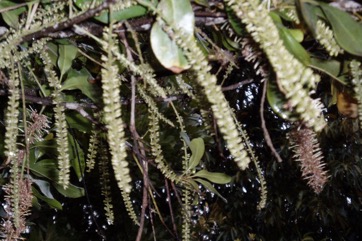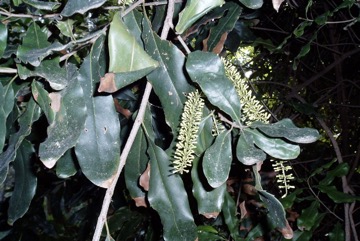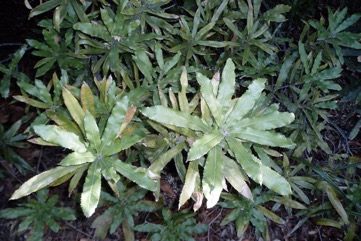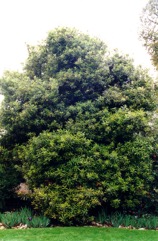Macadamia, Rough Shelled Bush Nut

It is a subtropical plant. It can grow from temperate to tropical climates. It is grown in the highlands in the tropics. It grows naturally in Australia in the rainforest. It suits humid locations. It can grow in full sun or light shade. It will tolerate light frost. It needs a well-drained soils and benefits from mulching. It is more cold resistant than the Macadamia integrifolia. In Melbourne Botanical Gardens. It suits hardiness zones 9-11.
Also known as:
Bopple nut, Mukandania, Nuez de macadamia, Pohon kacang makadam
Edible Portion
- Seeds kernel, Nuts
Where does Macadamia grow?
Found in: Africa, Asia, Australia, Brazil, Central America, China, Colombia, Cook Islands, Costa Rica, East Africa, Ethiopia, Fiji, Hawaii, Indonesia, Jamaica, Kenya, Malawi, Mexico, North America, Pacific, Papua New Guinea, PNG, Samoa, SE Asia, Singapore, South Africa, Southern Africa, South America, Tanzania, Tonga, United States, Venezuela, Zimbabwe
Notes: There are about 14 Macadamia species. They are mainly in Australia.
Status: Introduced into Papua New Guinea. Although not yet common in Papua New Guinea it is probably one of the nuts worth promoting. It is a cultivated food crop.
Growing Macadamia, Rough Shelled Bush Nut
Cultivation: Plants can be grown from seed. Fresh seed should be used and seeds germinate and grow easily. Budding or grafting onto seedlings is possible. They can be grown from cuttings.
Edible Uses: The nuts are eaten raw, roasted, fried or used in ice cream, nut butters, confectionery, bread, salads, sauces, cakes, biscuits, soups and milk shakes. The nuts are rich in oil.
Production: In Australia, the nuts are ripe January to March.
Nutrition Info
per 100g edible portion| Edible Part | Energy (kcal) | Protein (g) | Iron (mg) | Vitamin A (ug) | Vitamin c (mg) | Zinc (mg) | % Water |
|---|---|---|---|---|---|---|---|
| - | - | - | - | - | - |
Macadamia, Rough Shelled Bush Nut Photos




References
Alice, L. & O'Quinn, T., Australian Bush Superfoods. Explore Australia p 102
Arora, R. K., 2014, Diversity in Underutilized Plant Species - An Asia-Pacific Perspective. Bioversity International. p 96
Blomberry, A.M., 1979, Australian Native Plants. Angus and Robertson p 172
Bodkin, F., 1991, Encyclopedia Botanica. Cornstalk publishing, p 663
Brouk, B., 1975, Plants Consumed by Man. Academic Press, London. p 218
Cheifetz, A., (ed), 1999, 500 popular vegetables, herbs, fruits and nuts for Australian Gardeners. Random House p 199
Cribb, A.B. & J.W., 1976, Wild Food in Australia, Fontana. p 89
Cull, B.W., 1995, Fruit Growing in Warm Climates. Reed. p 103
Cundall, P., (ed.), 2004, Gardening Australia: flora: the gardener's bible. ABC Books. p 848
Darley, J.J., 1993, Know and Enjoy Tropical Fruit. P & S Publishers. p 77
Dharani, N., 2002, Field Guide to common Trees & Shrubs of East Africa. Struik. p 123
Doran, J.C., & Turnbull, J.W. (Eds), 1997, Australian Trees and Shrubs: species for land rehabilitation and farm plantings in the tropics. ACIAR Monograph No 24. p 306
Elliot, W.R., & Jones, D.L., 1993, Encyclopedia of Australian Plants suitable for cultivation. Vol 6. Lothian. p 264
Etherington, K., & Imwold, D., (Eds), 2001, Botanica's Trees & Shrubs. The illustrated A-Z of over 8500 trees and shrubs. Random House, Australia. p 452
Facciola, S., 1998, Cornucopia 2: a Source Book of Edible Plants. Kampong Publications, p 189
Flora of Australia Volume 16, Elaeagnaceae, Proteaceae 1. Melbourne: CSIRO Australia (1995) p 420
Flora of China @ efloras.org Volume 5
Glowinski, L., 1999, The Complete Book of Fruit Growing in Australia. Lothian. p 109
Heyne, G. & P., 1985, Australian Plants for your Garden. Lothian. p 131
Hibbert, M., 2002, The Aussie Plant Finder 2002, Florilegium. p 188
Jones D, L, 1986, Ornamental Rainforest Plants in Australia, Reed Books, p 50
Lazarides, M. & Hince, B., 1993, Handbook of Economic Plants of Australia, CSIRO. p 154
Lorenzi, H., Bacher, L., Lacerda, M. & Sartori, S., 2006, Brazilian Fruits & Cultivated Exotics. Sao Paulo, Instituto Plantarum de Estuados da Flora Ltda. p 477
Lord, E.E., & Willis, J.H., 1999, Shrubs and Trees for Australian gardens. Lothian. p 18
Low, T., 1991, Wild Food Plants of Australia. Australian Nature FieldGuide, Angus & Robertson. p 92
Macmillan, H.F. (Revised Barlow, H.S., et al) 1991, Tropical Planting and Gardening. Sixth edition. Malayan Nature Society. Kuala Lumpur. p 303
Martin, F. W., et al, 1987, Perennial Edible Fruits of the Tropics. USDA Handbook 642 p 52
Mbuya, L.P., Msanga, H.P., Ruffo, C.K., Birnie, A & Tengnas, B., 1994, Useful Trees and Shrubs for Tanzania. Regional Soil Conservation Unit. Technical Handbook No 6. p 322
Menninger, E.A., 1977, Edible Nuts of the World. Horticultural Books. Florida p 23
Molyneux, B. and Forrester, S., 1997, The Austraflora A-Z of Australian Plants. Reed. p 133
Nicholson, N & H., 1996, Australian Rainforest Plants, Terania Rainforest Publishing. NSW. p 42
Plants for a Future database, The Field, Penpol, Lostwithiel, Cornwall, PL22 0NG, UK. http://www.scs.leeds.ac.uk/pfaf/
Proc. Linn. Soc. New South Wales 79:15. 1954
Recher, P, 2001, Fruit Spirit Botanical Gardens Plant Index. www.nrg.com.au/~recher/ seedlist.html p 2
Segura, S., et al, 2018, The edible fruit species in Mexico. Genet Resour Crop Evol (2018) 65:1767–1793
Sleumer, H., 1955, Proteaceae in Flora Malesiana, Ser 1 Vol 5(2) p 198
Smith, A.C., 1985, Flora Vitiensis Nova, Lawaii, Kuai, Hawaii, Volume 3 p 752
Smith, K & I., 1999, Grow your own bushfoods. New Holland. Australia. p 92
Smith, P.M., 1979, Macadamia, in Simmonds, N.W., (ed), Crop Plant Evolution. Longmans. London. p 319
Stanley, T. D. & Ross, E. M., 1986, Flora of south-eastern Queensland Volume 2. Queensland Government p 15
Sukarya, D. G., (Ed.) 2013, 3,500 Plant Species of the Botanic Gardens of Indonesia. LIPI p 368
Tankard, G., 1990, Tropical fruit. An Australian Guide to Growing and using exotic fruit. Viking p 68
Thaman, R.R., 1976, The Tongan Agricultural System, University of the South Pacific, Suva, Fiji. p 409
USDA, ARS, National Genetic Resources Program. Germplasm Resources Information Network - (GRIN). [Online Database] National Germplasm Resources Laboratory, Beltsville, Maryland. Available: www.ars-grin.gov/cgi-bin/npgs/html/econ.pl (10 April 2000)
Wickens, G.E., 1995, Edible Nuts. FAO Non-wood forest products. FAO, Rome. p147
Williams, C.N., Chew, W.Y., and Rajaratnam, J.A., 1989, Tree and Field Crops of the Wetter Regions of the Tropics. Longman, p 130
Williams, J.B., Harden, G.J., and McDonald, W.J.F., 1984, Trees and shrubs in rainforests of New South Wales and Southern Queensland. Univ. of New England, Armidale. p 56
World Checklist of Useful Plant Species 2020. Royal Botanic Gardens, Kew
www.worldagroforestrycentre.org/treedb/